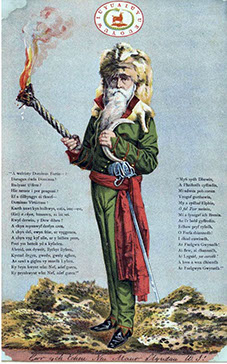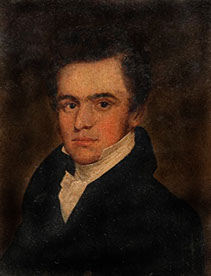
 The reminiscences of Dr William Price
The reminiscences of Dr William Price
appeared in the Cardiff Times in 1888, when Price was 88 years old. By then, public interest in the Doctor had little to do with his Chartist activities, some 40 years before. His notoriety stemmed from his Druidic activities and his championing of cremation.
Four years before in January 1884, he had attempted to cremate the body of his dead five month old son on a pyre of two tons of coal on the hillside at Llantrisant, watched by 20,000 people.
He won the court case brought against him by arguing that although not legal, cremation was not illegal, so he was able to go ahead with the ceremony and complete the cremation that March.
These are matters that his interviewer Gwilym Hughes, a National Eisteddfod bard himself (Gwilym ap id Anfryn), had already discussed with Price. Before tacking Chapter VI – The Chartist Riots, few of the newspaper’s readers would have appreciated that Price had been a Chartist – and an important one in 1839.

Hughes began by asking "Did you not take a very prominent part in the Chartist movement ?
"Yes, I took a very active interest in it. In the year 1839 I was living at Pontypridd. I lived there for a great number of years. I had property on the side opposite to Treforest."
“We were talking about the Chartists. What part did you take in the movement ?"
I was appointed the leader of the Pontypridd district. The other prominent persons were Frost, Zephaniah Williams, and John Jones. John Jones was a thorough good fellow, but I had not so good an opinion of Frost, I remember that I was to lead the people from Merthyr, Brecon, the Aberdare Valleys, Pontypridd, and Dinas; and Frost, with Zephaniah Williams and John Jones as subs., were to command the contingent from Blaenau and Pontypool. [A lapse of memory – Frost, Williams and Jones were the three transported ‘Welch Martyrs’. John Jones was leader of the Aberdare Chartists. Price was talking about William Jones, watchmaker and publican at Pontypool.]
Frost had been a mayor of Newport, and was shopkeeper in that town. Six weeks before the Chartist riots he sent for the delegates to meet him at Twyn-y-star, Blaenau Gwent. I went there as the delegate from the Merthyr and Aberdare district. Frost, who was chairman, said, I have called you together to ask will you rise at my bidding, for it must be done ?' Well, upon that, one of the delegates, an old soldier named David Davies, of Abersychan, who had served for 25 years in the army, and had fought in the battle of Waterloo, got up, and said, 'I will tell you, Mr Frost, the condition upon which my lodge will rise, and there is no other condition as far as I am concerned. The Abersychan Lodge is 1,600 strong 1200 of them are old soldiers the remaining 400 have never handled arms, but we can turn them into fighting men in no time. I have been sent here to tell you that we shall not rise until you give us a list of those we are to remove—to kill. I know what the English army is, and I know how to fight them, and the only way to succeed is to attack and remove those who command them - the officers and those who administer the law, We must be led as the children of Israel were led from 'Egypt through the Red Sea.' This we understood to be a sea of blood. Every delegate gave a similar reply, and Frost promised that he would not call them up until he had given them the list asked for. That meeting lasted until two or three o'clock in the morning.
In about six weeks afterwards, on a Saturday night, Frost sent a person named Isaac Morgan—who was lately killed accidentally in London—to me with a request that I should see him early on the following morning. [Sunday 27th October 1839; Both Wilks (1984) and Jones (1985) are uncertain about the date of the Tywn Y Star meeting at Dukestown] I obeyed the summons, and when I saw him Frost had a shy distrustful look which I did not at all like. He led me into a well-furnished apartment, and there, behind the door, stood a large screen some six or seven feet high. Frost continually cast his eye in the direction of the screen, so I at once suspected that he had someone concealed there. I did not say anything, however, but took care to converse in a low whisper, so that my voice could not be heard at the other side of the room. I took hold of Frost by the coat, and pulled him gently towards the window, and there I asked him why he had sent for me. “Have you not heard?” said he.
“I have heard nothing after the Twyn-y-star meeting,' I answered.
‘Well’ he said, ‘We are going to rise this night week, and I want to know whether you will meet us here.'
‘Where is your plan?' I asked. 'I will not budge until I have everything explained.'
He said that the plan was in the printing office of Mr Ethridge. I then asked for the original, but he could not produce, it, and I refused to agree to anything except what had been decided at the Twyn-y-star meeting.
[This document outlined the structure of a paramilitary organisation based upon units of ten. It was returned to Etheridge when his case was dropped and on the advice of Feargus O’Connor, he burned it]
‘What’ said he, ‘do you want us to kill the soldiers- kill a thousand of them in one night?' ‘Yes,' I said, 'a hundred thousand, if it is necessary.'
‘Dear me,' cried he,' I cannot do it, I cannot do it,' and then he cried like a child and talked about heaven and hell, I cursed him, and said, 'You shall not put a sword in my hand and a rope around my neck at the same time. If I take a sword in my hand I will use it, and no one shall take it from me but at the cost of my life.' I then left him.
The rising took "place. as he said it would, that night week - I think it was Sunday, the 4th of November, 1839 [Sunday the 3rd – they arrived in Newport in the morning of November 4th] - but no one from Merthyr or the Aberdare district took part in it. Frost and Zephaniah Williams had about 20,000 persons from Blaenau under their command and John Jones, watchmaker, commanded a contingent of 16,000 brave fellows from Pontypool. [How accurate are these figures?]
They, however, did not come nearer Newport than Cefn tre-farchog, where they heard of the treachery at Newport. Frost's contingent came down that night to a place called Rhiwderyn, Bassaleg. [He sounds muddled, but was he?] It rained in torrents all night and the following morning, so that the poor fellows were not fit for anything. When at last they were brought to Newport they found the Westgate was filled with soldiers, who fired at the Chartists from the windows. Nine brave fellows were killed on the spot. [nine bodies collected by the army from the building; ten bodies were buried at St, Woolos churchyard; ‘upwards of twenty died (Merlin)] If the Chartists had only been properly commanded and directed they could have carried everything before them. It is evident to me that Frost wanted to destroy the Chartist movement, and that he kept his men for hours in the rain in order to give the soldiers time to fill Westgate."
But if Frost was a traitor to the cause, how do you account for the fact that he was afterwards transported for life for having led the attack on Newport ?"
What I have said I can prove—so there. I will take my oath that he had some one behind the screen in the room on the day that I met him in his own house."
“Well, and how do you know this ?"
"Because, for one thing, what I said then in the presence of Frost was repeated to me soon afterwards by Mr Coles, curate of Michaelstone-fedw."
"You say that you took no part in the attack on Newport?"
“No, I was not there, and it was a good thing for me that I was not. Mr Coles warned me not to come to Newport, as directions had been given to the soldiers to shoot the man with the long hair.' Of course, that was me, and some poor fellow, who had the misfortune to possess long hair like mine, was mistaken for me, and was actually shot down dead as he sat on the arm of a lamp-post witnessing the riot."
Transcription and Annotation by Les James
CHAPTER VI —THE CHARTIST RIOTS
From the Cardiff Times & South Wales Weekly News, 26 May 1888 (Welsh Newspapers, NLW)
There will be a further article about The Reminiscences of Dr. Price in the next edition of CHARTISM eMAG
More about Dr Price can be found in the downloadable PDF "A Welsh Heretic" by Islwyn ap Nicholas









